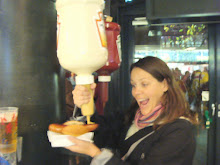 This weekend Kevin and I had the honor of attending the wedding of one of Kevin's co-workers. This was the first European wedding that I've been invited to, and I was excited to see how it differs from a wedding in the U.S.
This weekend Kevin and I had the honor of attending the wedding of one of Kevin's co-workers. This was the first European wedding that I've been invited to, and I was excited to see how it differs from a wedding in the U.S.The wedding was held in Goldegg, Austria. The town is located about 60 kilometers (just under 40 miles) outside of Salzburg, Austria. Nestled in the Hohe Tauern, the highest in the Austrian Alps, it is a popular ski destination. It is also home to several wellness centers and where the bride's family has owned a weekend home for generations.
The event’s setting was truly idyllic: a medieval church overlooking a
 lake in the tiny town center followed by a cocktail reception at the adjoining castle. But, what made the event a true highlight of my European experience was the attire.
lake in the tiny town center followed by a cocktail reception at the adjoining castle. But, what made the event a true highlight of my European experience was the attire.The invitation requested that guests wear "Fest Tracht," traditional Austrian (and Bavarian) dress. That meant dirndls for the women and lederhosen or steireranzug for the men. For those of you who don't know what these outfits are, picture Oktoberfest or the Sound of Music. I felt like I stepped out of the 21st century and into a timeless era where everyone was dressed movie-set perfect.
Tracht originally was the everyday clothing of rural people in Bavaria and the Alps. Made from cotton, wool, leather, and loden (a water-resistant material made from sheep's wool) tracht became popular "sportswear" for Austrian and Bavarians in the 19th century. The clothing is well suited for hunting and other outdoor pursuits. Today, tracht is still popular dress for weddings and other social and cultural events.
 Dirndls consist of full skirts with an apron, white blouses, and a tight-fitting bodice. It's too bad women can't wear these ensembles ever day because every woman - old and young, fat and thin - looks good in a dirndl. They accentuate your chest and make your waist nice and skinny.
Dirndls consist of full skirts with an apron, white blouses, and a tight-fitting bodice. It's too bad women can't wear these ensembles ever day because every woman - old and young, fat and thin - looks good in a dirndl. They accentuate your chest and make your waist nice and skinny.The men's outfits were equally impressive. Some men wore lederhosen, which literally translates as leather pants. They are full, knee-length or short trousers usually made from leather. The shorts are worn with wool socks. Some also include suspenders and ornate brackets going across the man's chest. The Steireranzug consisted mostly of long pants made of loden in grayish green. The jackets vary by region, but most of the men at this wedding had jackets with collars that stood up and a half belt that buttoned in the back.
 Kevin and I received a "pass" from the bride and groom, and were told that it was okay to wear normal formal dress instead. Having been told that these outfits are rather expensive to purchase — a nice quality outfit can cost upward of several hundred Euros — and not knowing if a maternity dirndl is even an option, I figured that we would not be the only guests to forgo the tracht.
Kevin and I received a "pass" from the bride and groom, and were told that it was okay to wear normal formal dress instead. Having been told that these outfits are rather expensive to purchase — a nice quality outfit can cost upward of several hundred Euros — and not knowing if a maternity dirndl is even an option, I figured that we would not be the only guests to forgo the tracht.I was surprised that we — in a dark suit and party dress — were in the minority by a long shot. Out of the nearly 200 people at the wedding, I'd say over three quarters of the guests were dressed traditionally. When the dancing started and the floor was filled with people in their tracht doing a waltz it was really a site to behold.





1 comment:
nice post love reading it.
Post a Comment